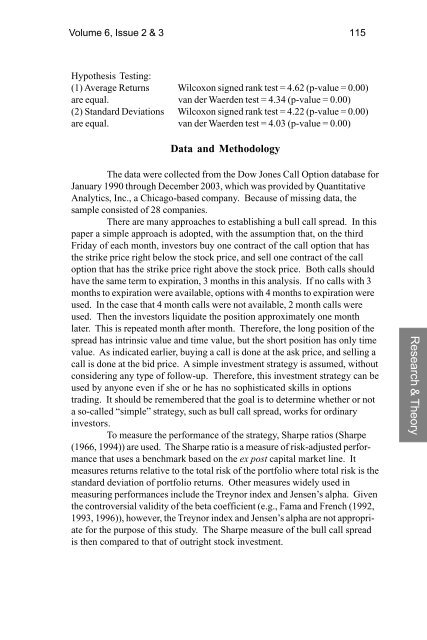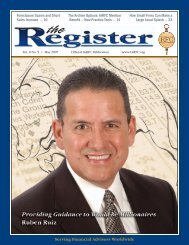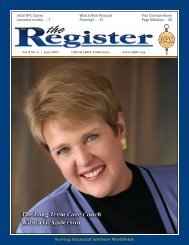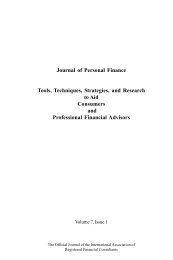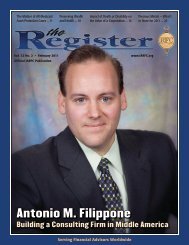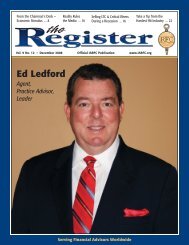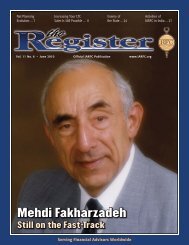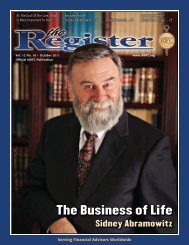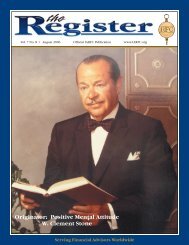3433-vol. 6 issue 2-3.pmd - iarfc
3433-vol. 6 issue 2-3.pmd - iarfc
3433-vol. 6 issue 2-3.pmd - iarfc
Create successful ePaper yourself
Turn your PDF publications into a flip-book with our unique Google optimized e-Paper software.
Volume 6, Issue 2 & 3 115<br />
Hypothesis Testing:<br />
(1) Average Returns Wilcoxon signed rank test = 4.62 (p-value = 0.00)<br />
are equal. van der Waerden test = 4.34 (p-value = 0.00)<br />
(2) Standard Deviations Wilcoxon signed rank test = 4.22 (p-value = 0.00)<br />
are equal. van der Waerden test = 4.03 (p-value = 0.00)<br />
Data and Methodology<br />
The data were collected from the Dow Jones Call Option database for<br />
January 1990 through December 2003, which was provided by Quantitative<br />
Analytics, Inc., a Chicago-based company. Because of missing data, the<br />
sample consisted of 28 companies.<br />
There are many approaches to establishing a bull call spread. In this<br />
paper a simple approach is adopted, with the assumption that, on the third<br />
Friday of each month, investors buy one contract of the call option that has<br />
the strike price right below the stock price, and sell one contract of the call<br />
option that has the strike price right above the stock price. Both calls should<br />
have the same term to expiration, 3 months in this analysis. If no calls with 3<br />
months to expiration were available, options with 4 months to expiration were<br />
used. In the case that 4 month calls were not available, 2 month calls were<br />
used. Then the investors liquidate the position approximately one month<br />
later. This is repeated month after month. Therefore, the long position of the<br />
spread has intrinsic value and time value, but the short position has only time<br />
value. As indicated earlier, buying a call is done at the ask price, and selling a<br />
call is done at the bid price. A simple investment strategy is assumed, without<br />
considering any type of follow-up. Therefore, this investment strategy can be<br />
used by anyone even if she or he has no sophisticated skills in options<br />
trading. It should be remembered that the goal is to determine whether or not<br />
a so-called “simple” strategy, such as bull call spread, works for ordinary<br />
investors.<br />
To measure the performance of the strategy, Sharpe ratios (Sharpe<br />
(1966, 1994)) are used. The Sharpe ratio is a measure of risk-adjusted performance<br />
that uses a benchmark based on the ex post capital market line. It<br />
measures returns relative to the total risk of the portfolio where total risk is the<br />
standard deviation of portfolio returns. Other measures widely used in<br />
measuring performances include the Treynor index and Jensen’s alpha. Given<br />
the controversial validity of the beta coefficient (e.g., Fama and French (1992,<br />
1993, 1996)), however, the Treynor index and Jensen’s alpha are not appropriate<br />
for the purpose of this study. The Sharpe measure of the bull call spread<br />
is then compared to that of outright stock investment.<br />
Research & Theory


